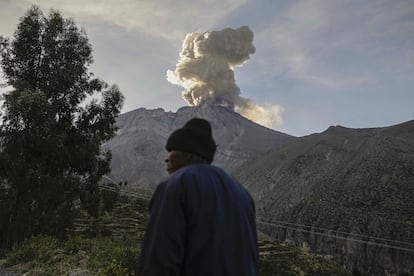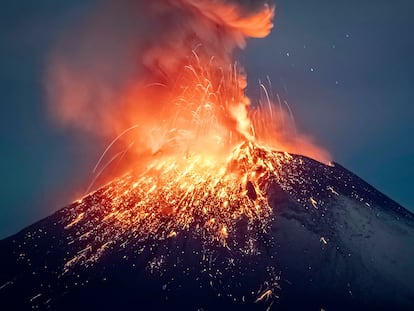Peru declares state of emergency over Ubinas volcano after 17 blasts and 170 quakes in two days
The measure affects seven districts near the crater, located in the Moquegua region, in the south of the country, where there had been no risk episodes since 2019

Since early Tuesday morning, a shower of ash has endangered at least 2,000 people in southern Peru. Ubinas, the most active volcano among the 400 volcanic structures in the Andean country, has become active again, triggering concerns among authorities and the people of nearby towns. Since its initial eruption, which formed an ash column up to five kilometers high and dispersed within a radius of 10 kilometers, there have been 17 explosions in the past two days. Those affected are having trouble breathing due to the ash and dust that has covered their homes, in addition to the smell of burnt fuel.
The last time Ubinas, located in the Moquegua region, showed volcanic activity was in July 2019. The eruptions, which lasted for three months, reached eight kilometers above the crater, and dispersed within a radius of 250 kilometers. Although the Geophysical Institute of Peru (IGP) has predicted that this eruption will be no more than moderate, the duration and real magnitude cannot be determined precisely.
On Wednesday, the government Cabinet approved the declaration of a state of emergency in seven districts of the General Sánchez Cerro province in Moquegua for 60 days. These districts are Coalaque, Chojata, Ichuña, Lloque, Matalaque, Ubinas, and Yunga. The declaration states, “It has been determined that the population, cultivated areas, among others, are exposed to very high risk due to the eruptive process of the Ubinas volcano, with the condition of imminent danger being recognised.” The document also justifies the decision, citing that “the response capacity of the Moquegua regional government has been exceeded; therefore, the technical and operational intervention of government entities is necessary.”
In the afternoon, Prime Minister Alberto Otárola explained that the measure will allow them to take immediate and exceptional actions to reduce the risk, as well as response and rehabilitation interventions. “The government’s central task is to protect the population,” he emphasized. For now, Minister of Transport and Communications Paola Lazarte will travel to the area on Thursday. Due to the emergency, classes have been suspended in 13 early education, primary and secondary education centers, as well as two institutes.
One of the challenges in dealing with the Ubinas volcano explosions is where to accommodate the evacuated citizens. The Sirahuaya shelter, located 12 kilometers from the crater, has not been operational since its establishment in 2019. Local authorities are working against the clock to make it operational. “We are complementing what the previous administrations left us. We will need 14 million soles [almost $4 million]. We are waiting for the declaration of emergency to begin the work, but it can welcome families,” declared Juan Paredes Urbiola, the sub-manager of Disaster Risk Management of the Moquegua regional government. However, some citizens think otherwise. “The Sirahuaya shelter consists of small modules with only a bed, but there is no water, sewage, or electricity. Between dying there or dying here, honestly, we would prefer to die at home,” said Rocío Ramos, a resident of the Ubinas district, in statements to the newspaper El Comercio.
Although the Geological, Mining, and Metallurgical Institute (Ingemmet) reported that on Wednesday the continuous ash emissions reached a maximum height of 1,000 meters above the crater — a smaller magnitude than the first day — the threat is still present as the IGP has detected 173 earthquakes associated with rock fractures occurring inside the volcano.
On the other hand, various volcanologists have warned that volcanic ash, being highly toxic, will have a severe impact on agriculture, livestock, and, of course, the environment. Cases of intoxication may occur. The National Service of Meteorology and Hydrology of Peru (Senamhi) has warned that between Thursday, July 6, and Saturday, July 8, winds blowing to the east and northwest will promote the dispersion of ash, also affecting the Arequipa region. Ubinas is currently on orange alert.
Sign up for our weekly newsletter to get more English-language news coverage from EL PAÍS USA Edition
Tu suscripción se está usando en otro dispositivo
¿Quieres añadir otro usuario a tu suscripción?
Si continúas leyendo en este dispositivo, no se podrá leer en el otro.
FlechaTu suscripción se está usando en otro dispositivo y solo puedes acceder a EL PAÍS desde un dispositivo a la vez.
Si quieres compartir tu cuenta, cambia tu suscripción a la modalidad Premium, así podrás añadir otro usuario. Cada uno accederá con su propia cuenta de email, lo que os permitirá personalizar vuestra experiencia en EL PAÍS.
¿Tienes una suscripción de empresa? Accede aquí para contratar más cuentas.
En el caso de no saber quién está usando tu cuenta, te recomendamos cambiar tu contraseña aquí.
Si decides continuar compartiendo tu cuenta, este mensaje se mostrará en tu dispositivo y en el de la otra persona que está usando tu cuenta de forma indefinida, afectando a tu experiencia de lectura. Puedes consultar aquí los términos y condiciones de la suscripción digital.
More information
Archived In
Últimas noticias
Trump claims peace in Ukraine is near, but Moscow suggests otherwise
A survivor’s account of the Interoceanic Train accident: ‘We were scared because of the speed on the curve’
The Interoceanic Train, the Mexican alternative to the Panama Canal
What is known about the Interoceanic Train derailment in Oaxaca
Most viewed
- Oona Chaplin: ‘I told James Cameron that I was living in a treehouse and starting a permaculture project with a friend’
- Reinhard Genzel, Nobel laureate in physics: ‘One-minute videos will never give you the truth’
- Why the price of coffee has skyrocketed: from Brazilian plantations to specialty coffee houses
- Pablo Escobar’s hippos: A serious environmental problem, 40 years on
- Chevy Chase, the beloved comedian who was a monster off camera: ‘Not everyone hated him, just the people who’ve worked with him’











































